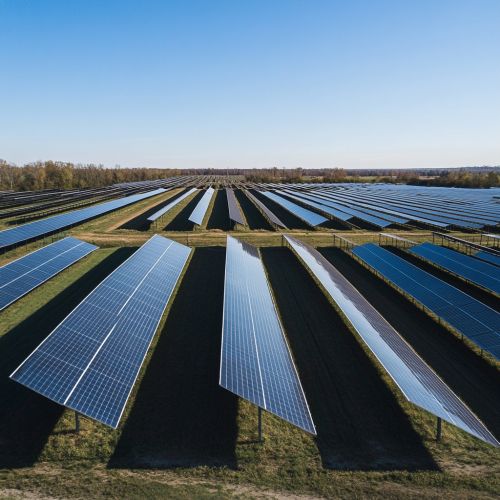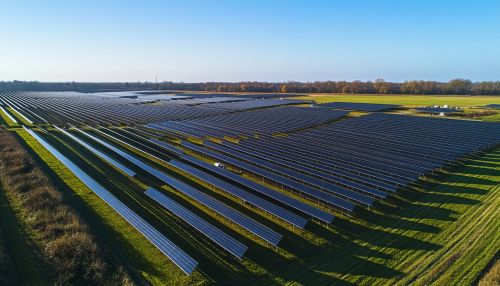Solar power plant: Difference between revisions
(Created page with "== Introduction == A '''solar power plant''' is a facility that converts sunlight into electricity using various technologies. These plants are a crucial component of the renewable energy sector, helping to reduce reliance on fossil fuels and decrease greenhouse gas emissions. Solar power plants can be classified into different types based on the technology used, such as photovoltaic (PV) systems and concentrated solar power (CSP) systems. This article explores the intr...") |
No edit summary |
||
| Line 13: | Line 13: | ||
PV power plants can be further divided into utility-scale and distributed generation systems. Utility-scale PV plants are large installations that supply electricity to the grid, while distributed generation systems are smaller and often installed on rooftops or in community solar projects. | PV power plants can be further divided into utility-scale and distributed generation systems. Utility-scale PV plants are large installations that supply electricity to the grid, while distributed generation systems are smaller and often installed on rooftops or in community solar projects. | ||
[[Image:Detail-98471.jpg|thumb|center|Aerial view of a large solar farm with rows of solar panels under a clear blue sky.|class=only_on_mobile]] | |||
[[Image:Detail-98472.jpg|thumb|center|Aerial view of a large solar farm with rows of solar panels under a clear blue sky.|class=only_on_desktop]] | |||
=== Concentrated Solar Power Plants === | === Concentrated Solar Power Plants === | ||
Latest revision as of 23:58, 14 October 2024
Introduction
A solar power plant is a facility that converts sunlight into electricity using various technologies. These plants are a crucial component of the renewable energy sector, helping to reduce reliance on fossil fuels and decrease greenhouse gas emissions. Solar power plants can be classified into different types based on the technology used, such as photovoltaic (PV) systems and concentrated solar power (CSP) systems. This article explores the intricate details of solar power plants, including their design, operation, and impact on the energy landscape.
Types of Solar Power Plants
Solar power plants are primarily categorized into two types: photovoltaic (PV) power plants and concentrated solar power (CSP) plants.
Photovoltaic Power Plants
Photovoltaic power plants use solar panels composed of numerous solar cells to convert sunlight directly into electricity. These cells are made from semiconductor materials, such as silicon, which exhibit the photovoltaic effect. When sunlight strikes the solar cells, it excites electrons, creating an electric current.
PV power plants can be further divided into utility-scale and distributed generation systems. Utility-scale PV plants are large installations that supply electricity to the grid, while distributed generation systems are smaller and often installed on rooftops or in community solar projects.


Concentrated Solar Power Plants
Concentrated Solar Power (CSP) plants use mirrors or lenses to concentrate a large area of sunlight, or solar thermal energy, onto a small area. The concentrated light is converted into heat, which drives a heat engine connected to an electrical power generator. CSP systems are typically used for large-scale power generation and can incorporate thermal energy storage systems to provide electricity even when the sun is not shining.
CSP technologies include parabolic troughs, solar power towers, and dish Stirling systems. Each technology has its unique design and operational characteristics, making them suitable for different applications and geographic locations.
Components of Solar Power Plants
Solar power plants consist of several key components that work together to generate electricity.
Solar Panels and Collectors
In PV plants, solar panels are the primary component, consisting of multiple solar cells connected in series and parallel to achieve the desired voltage and current. In CSP plants, solar collectors, such as mirrors or lenses, are used to focus sunlight onto a receiver.
Inverters
Inverters are crucial in PV systems as they convert the direct current (DC) produced by solar panels into alternating current (AC), which is used by the electrical grid. In CSP systems, inverters may not be necessary if the generated electricity is already in AC form.
Energy Storage Systems
Energy storage systems, such as batteries or thermal storage, are often integrated into solar power plants to store excess energy for use during periods of low sunlight. This capability enhances the reliability and stability of solar power plants, allowing them to supply electricity even during cloudy days or at night.
Grid Connection and Control Systems
Solar power plants are connected to the electrical grid through transformers and substations. Control systems are employed to manage the plant's operation, optimize energy production, and ensure grid stability.
Design and Construction
The design and construction of a solar power plant involve several stages, including site selection, engineering design, procurement, and construction.
Site Selection
Choosing an appropriate site is critical for the success of a solar power plant. Factors such as solar irradiance, land availability, proximity to transmission lines, and environmental impact are considered during site selection. Areas with high solar insolation, minimal shading, and flat terrain are ideal for solar power plants.
Engineering Design
The engineering design phase involves detailed planning of the plant layout, selection of technology, and sizing of components. Engineers consider factors such as the angle and orientation of solar panels, spacing between rows, and the integration of energy storage systems.
Procurement and Construction
Procurement involves sourcing the necessary materials and equipment, such as solar panels, inverters, and mounting structures. Construction includes site preparation, installation of solar panels or collectors, and connection to the grid. This phase requires skilled labor and careful project management to ensure timely completion and adherence to safety standards.
Operation and Maintenance
The operation and maintenance (O&M) of solar power plants are essential to ensure optimal performance and longevity.
Monitoring and Performance Optimization
Continuous monitoring of the plant's performance is crucial to identify issues and optimize energy production. Advanced monitoring systems track parameters such as energy output, temperature, and weather conditions. Data analytics and machine learning techniques are increasingly used to predict maintenance needs and improve efficiency.
Regular Maintenance
Regular maintenance activities include cleaning solar panels to remove dust and debris, inspecting electrical connections, and servicing mechanical components. Preventive maintenance helps to minimize downtime and extend the lifespan of the plant.
Challenges in O&M
Challenges in the operation and maintenance of solar power plants include managing variability in solar irradiance, dealing with equipment failures, and ensuring grid stability. Technological advancements and innovative solutions are continually being developed to address these challenges.
Environmental and Economic Impact
Solar power plants have significant environmental and economic impacts, both positive and negative.
Environmental Benefits
Solar power plants contribute to reducing greenhouse gas emissions and air pollution by displacing fossil fuel-based electricity generation. They have a relatively low environmental footprint compared to conventional power plants, with minimal water usage and no direct emissions during operation.
Environmental Challenges
Despite their benefits, solar power plants can pose environmental challenges, such as land use and habitat disruption. Large-scale installations may require significant land areas, potentially affecting local ecosystems. Proper site selection and mitigation measures are essential to minimize these impacts.
Economic Considerations
The economic impact of solar power plants includes job creation, energy cost savings, and energy security. The solar industry has become a significant source of employment, with jobs in manufacturing, installation, and maintenance. Additionally, solar power can reduce electricity costs for consumers and enhance energy independence.
Financial Incentives and Policies
Government incentives and policies play a crucial role in the growth of solar power plants. Subsidies, tax credits, and feed-in tariffs are commonly used to encourage investment in solar energy. These incentives help to offset the initial costs and make solar power more competitive with traditional energy sources.
Technological Advancements
The solar power industry is continuously evolving, with technological advancements driving improvements in efficiency, cost, and scalability.
Advances in Photovoltaic Technology
Research and development in photovoltaic technology have led to the creation of more efficient solar cells, such as perovskite solar cells and bifacial panels. These innovations promise higher energy yields and lower production costs.
Innovations in Concentrated Solar Power
CSP technology has also seen significant advancements, including improvements in thermal storage systems and the development of hybrid systems that combine CSP with other renewable energy sources. These innovations enhance the reliability and flexibility of CSP plants.
Integration with Smart Grids
The integration of solar power plants with smart grids is an emerging trend that enhances grid management and energy distribution. Smart grids use advanced communication and control technologies to optimize the flow of electricity, accommodate variable renewable energy sources, and improve grid resilience.
Future Prospects
The future of solar power plants is promising, with continued growth and innovation expected in the coming decades.
Global Expansion
Solar power is projected to play a significant role in the global energy transition, with increasing deployment in both developed and developing countries. Efforts to expand access to electricity in remote and underserved regions are driving the adoption of solar power plants.
Challenges and Opportunities
While solar power plants offer numerous benefits, they also face challenges such as grid integration, energy storage, and policy uncertainty. Addressing these challenges requires collaborative efforts from governments, industry, and research institutions.
Role in Decarbonization
Solar power plants are a key component of strategies to decarbonize the energy sector and combat climate change. Their ability to provide clean, renewable energy makes them an essential part of the transition to a sustainable energy future.
